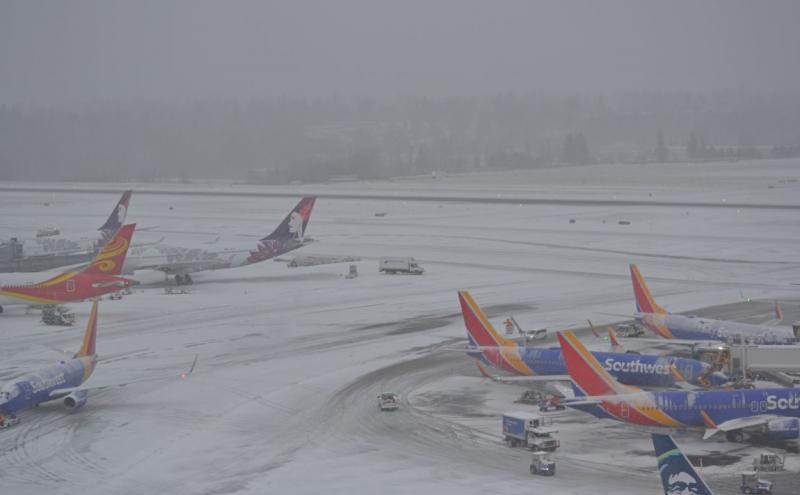
You’re heading over the river and through the woods to grandmother’s house. Trouble is, the weather report says there’s snow forecast for the morning you leave.
At SEA, we think winter is lovely weather for a plane ride together. We will keep the runways clear and the planes moving safely for you. Here’s more information on how that happens, with answers to your most frequently asked questions from travelers.
Q: Didn’t you guys anticipate this? What are you doing to manage this?
Yes we did! We actually start talking about snow while everyone else is still wearing flip flops. Every fall, we hold a Snow Symposium to brief the SEA team and our partners about snow operations for the upcoming season.
Months before the first flake flies, we’re getting ready by:
- Stocking up on sand (two types for runways and roadways) and de-icer fluid (for the runways, taxiways and taxi lanes [airlines use different fluids to de-ice their own aircraft]), training and refreshing team members like snowplow drivers
- Doing training drills on the snowplows
Keep in mind that Mother Nature does not always follow the rules when she throws a fit. We are ready and staffed up for whatever comes, but when there’s a big snowfall, it takes a little time to get operations back to normal. Safety is always our first priority so we take the time needed to do it right and get you on your way as quickly as possible.
When the flakes finally fall, the goal is to clear one runway in under 30 minutes.
Get more detail about what SEA does before, during, and after a storm and how you can stay in touch.
- Winter Weather 101
- Five Freezing Facts about Winter Weather at SEA
- All You Never Wanted to Know about Airplane De-icing
Q: Who’s in charge over there?
It’s a team effort that requires complicated collaboration across a number of different partners to get you to where you need to go safely and as quickly as possible. Everyone below is working hard to get you on your way:
Here’s the gist for snowflakes who just want the tip of the iceberg:
- SEA Airport maintains the terminal, airport facilities (like parking garage), runways, and getting passengers between airport facilities
- Airlines manage their schedules (arrivals and departures), their planes, customer service, and de-icing operations
- The FAA manages plane traffic in the air and takeoffs and landings
- TSA handles security checkpoints at the airport
- City and state governments handle maintenance of the roads feeding the airport
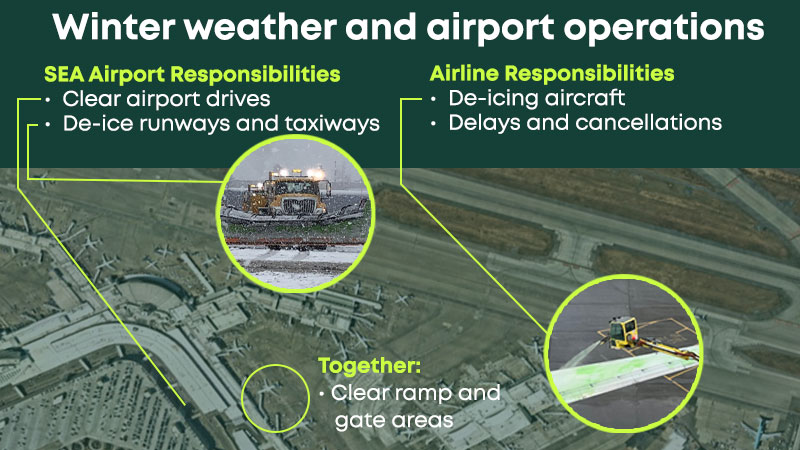
SEA Airport
The SEA team is responsible for maintaining the terminal and facilities, including:
- Keeping the terminal area free of snow and ice
- Maintaining the parking garage and roads and drives, including Starling Road, Air Cargo Road to the Employee Parking Lot, and the Airport Expressway just north of the return-to-terminal loop
- Removing snow and ice from the roadways
- During heavy snowfalls of two inches or more and accumulating, the airport hires two contractors to remove and collect snow piles. One for the north side of the ramp, and one for the south end
- De-icing and plowing the airfield and runways
- Plowing and de-icing the parking garages
- Running shuttle buses between the terminal and the rental car facility and employee parking lots
When the weather goes south, the SEA team opens the Snow Control Center, a central management facility for all airport snow and ice control activities. The Snow Team is staffed 24/7 during the snow incident and runs inclement weather operations with multiple representatives from Airport Operations, Aviation Maintenance, and Customer Service.
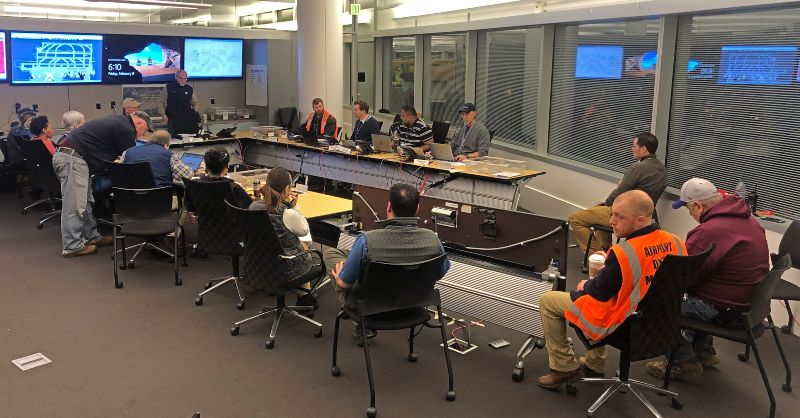
Airlines
The airline partners are working hard at:
- Scheduling their flight arrivals and departures
- Staffing flights and gates for departing and arriving flights
- Providing de-icing fluids and applying it to their planes once they have pulled back from the gates
- Notifying passengers of flight delays or cancellations
- Rescheduling passengers on delayed or cancelled flights
- Keeping their leased areas free of ice and snow
Federal Aviation Administration (FAA)/Air Traffic Control
They have a big job and are experts at directing flights in the air and takeoffs and landings at every airport in the country.
- Learn more about the FAA and how they mitigate the impact of weather
Did you know:
- At any given moment there are approximately 5,000 aircraft traversing the U.S. skies
- The FAA is a year-round, 24/7 operation, responsible for 5.3 million square miles of U.S. domestic airspace and 24 million square miles of U.S. airspace over the oceans
- There are 43,290 average daily flights in and out of the U.S.
TSA
The Transportation Security Administration (TSA) staffs and manages security checkpoints and screening at every airport in the country. They also manage the Federal Air Marshals program and train their own explosive detection canines.
National Weather Service
We also rely on our friends with the National Weather Service who host webinars to answer questions on weather conditions that help us prepare for future shifts. There is also a weather station right at the airport.
Other Municipalities
Maintaining the roads on the way to the airport is a cooperative effort by several local governments.
Port of Seattle/SEA Airport maintains the following areas and services:
- Bus fleet and roadways between the employee parking lot and the service tunnel
- Passenger buses and route between the terminal and the rental car facility
- A portion of South 160th Street in SeaTac
- Air Cargo Road from 28th Avenue South to 154th Street South on the North end
- Access from Highway 99 to the North Employee Parking Lot at 154th Street South
The City of SeaTac maintains:
- Highway 99 near the airport
- 154th Street South
- Side streets like South 160th Street
- Bus routes along the way to the airport
The Washington State Department of Transportation (WSDOT) manages:
- State Route 518
- State Route 509
- International Boulevard
- Interstate 5
- Get WSDOT updates
Is the airport open?
The simple answer is yes, but it’s a more complicated question depending upon what you mean — the terminal, or the airspace and flight operations.
Terminal
The airport facility itself is always open, and it’s extremely rare and a very limited duration when all three runways have ever been closed. Even during 9-11, the SEA airport terminal remained open as the Federal Aviation Administration closed U.S. airspace. The last time there was any facility closure was four hours during the 2012 ice storm.
The SEA staff keeps the airport infrastructure open and operating so flights can take off and land.
Airport employees are working around the clock, runways are getting cleared, and the snowplows and shoveling staff are out maintaining the terminal area. A significant weather event could mean reduced operating hours for airline ticket counters, TSA checkpoints, or restaurants and retailers due to limited supplies and staffing, but rest assured that this is the exception rather than the rule. Another factor is the ability of TSA and retail staff to get to work, but there are always plans for essential airport staff to stay near the airport at hotels or in conference rooms.
Airspace and flight operations
The Federal Aviation Administration (FAA) has the authority to restrict the U.S. airspace and slow down arriving or departing flights.
And the airlines and pilots make the final decision about whether flights can operate based upon weather conditions.
For example, during the February 2019 storm, Alaska Airlines proactively cancelled two days’ worth of flights during the worst part of the storm until conditions improved. We all want you to stay safe, so we encourage you to stay home if you can during very bad weather conditions, take advantage of flexible cancellation policies, and check with your airline on your flight status.
But if you have to travel, there’s a great chance that the terminal is open and some flights are operating. We’re here to help and we will keep you warm and safe.
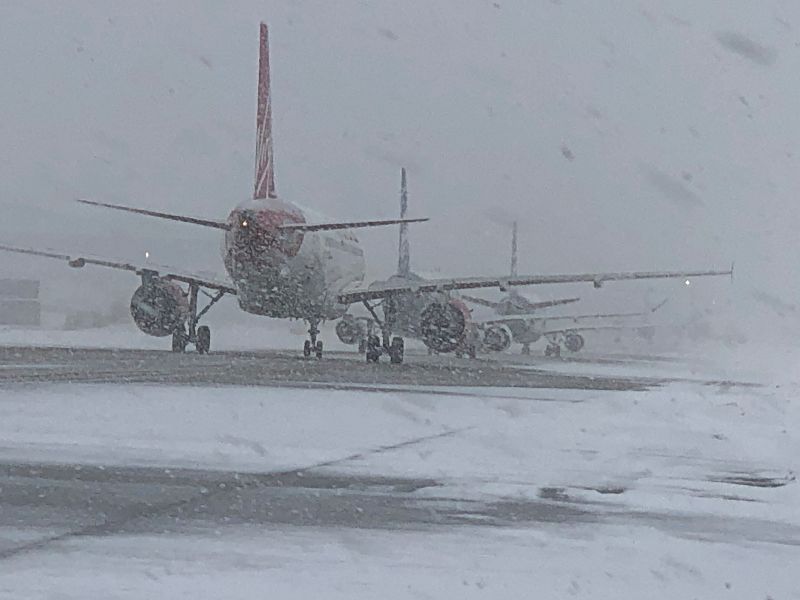
Q: Are flights still running? What in the world is a ground stop?
Even in the worst conditions, the airport stays open and the airlines keep operating. It just might be slower than normal if there is a ground stop.
Managing air traffic is a complicated dance that is handled by the FAA. Air traffic in our region is impacted by what’s happening in the rest of the complicated national system, like delays or heavy weather in the rest of the country. For example, if there is a ground stop in San Francisco and there are planes traveling there from SEA, that could impact flights.
The FAA has several tools to manage heavy weather:
- Ground stops: which keep aircraft on the ground when air traffic control is unable to safely accommodate additional aircraft in the system
- Ground delays: in which aircraft are delayed at their departure airport in order to manage demand and capacity at their arrival airport and
- Severe Weather Avoidance Plans: which minimize the impact of a large scale storm by easing traffic demand in portions of airspace impacted by the storm
Local weather at the airport is of course a factor. On a typical sunny day, SEA could see 50 airplane arrivals per hour. On a hazy or foggy day, it could decrease to 28 arrivals per hour. A ground stop is a situation when aircraft cannot come to the airport due to snow or fog (or other conditions like smoke) and they are being held in another airport like Portland or San Francisco.
Once airport landings are approved, the next task is to get airplanes in the sky sequenced correctly and start letting them back in. “Metering” begins, which means maintaining a level of separation between planes appropriate for the conditions and letting them land. Every flight is different depending upon departure time, destination, and international or domestic. So don’t assume that all flights are delayed — check with your airline for the most up to date information.
- Learn more about the FAA and its operations
- Video: See a Facebook Live Video about the basics of air traffic control and what happens in a low visibility situation
Q: Is my flight going to leave on time?
We really truly hope so and we are working efficiently and safely to ensure that airport conditions don’t slow you down. Here’s what impacts those decisions on your flight:
De-icing
De-icing operations are managed by the airlines and can be the number one thing that impacts departure. So keep in mind that although the door to the aircraft might close at the scheduled departure time, the plane will push back from the gate and get de-iced before your departure. And that it’s essential for your safety.
Air traffic control priorities
The FAA makes complicated decisions to assess every single flight. And arrivals and departures are handled differently. So, if there are delays in arriving flights, don’t assume that your flight will be delayed and vice-versa.
Airline operations
The first thing to know is that the airlines manage flight departures, arrivals, and schedules throughout the year, including bad weather conditions. So your first call should be to your airline, not the airport.
- The SEA team does not have arrivals and departures information (and it changes rapidly) so check with your airlines early and often. Use this directory of airlines that serve SEA
We know it’s frustrating to wait on the plane after landing. But there are several reasons this can happen at any airport, especially a fast-growing one like SEA where we see around 1,300 daily aircraft departures and arrivals. Airlines create their schedules with optimistic operating scenarios in mind — weather, staffing, no mechanical delays — and since airports cannot regulate the timing or number of planes scheduled, everybody works together to support the most harmonious and safe daily operation.
There are four main reasons it can take longer than expected to taxi to your gate after landing:
- Gate space
- Ground or crew availability
- A game of airport Tetris
- Fair weather (yes it’s true)
- Learn about the four reasons you’re sitting on the plane at SEA
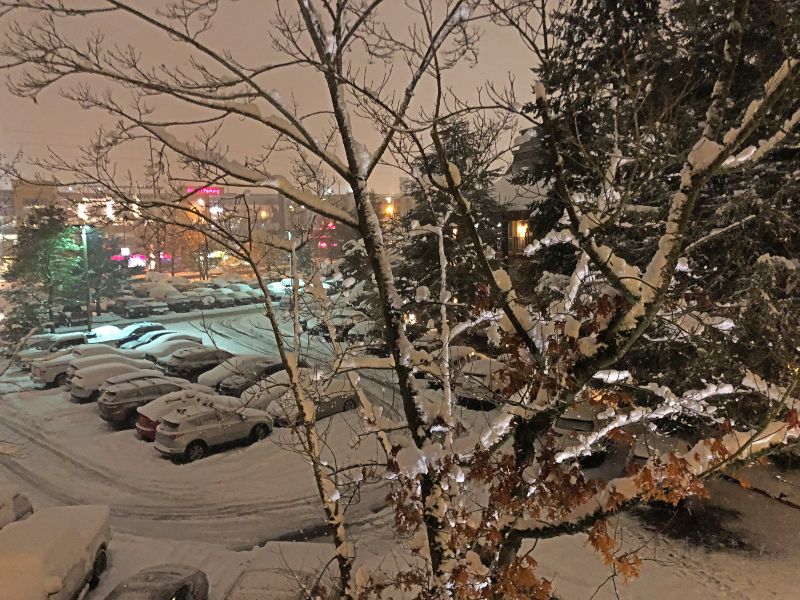
Q: How do I find out what’s happening?
Here’s how to stay in the know on the snow:
1. Monitor the media
If a storm is impacting airport operations, the media is the first to know about it.
2. Watch social media
During weather conditions the team is online and in the terminal for extended hours, but can't provide 24/7 real time coverage. Because conditions change rapidly, frequent updates could be irrelevant 30 minutes later. Major changes and stops are provided on SEA Airport social media.
3. Check the SEA Airport website
Watch the airport website for updates like:
- A colored bar (red or yellow) with a link to more information
- A rotating image that tells you about parking status or weather conditions
4. Register for your airline’s text alerts
If the airline has not said that your flight is delayed, you should come to the airport and expect your flight to depart. Check with your airline.
5. Check flight status and weather at SEA
- Watch your flight status on your airline’s website, social media, or app
- Get the weather conditions and forecast at SEA Airport from NOAA/The National Weather Service station located right at the airport. Check the weather
- Check the Flight Status on the SEA Airport page, which displays up to date information from every airline. This is the same information seen on the in-terminal flight information displays and comes directly from the airlines. You can use this page to check the status of specific flights or delays to or from another airport. For example, to check delays or cancellations for flights to Chicago, select the Chicago airport under Arrivals and Departures, then leave the airline blank. Check flight status
6. Plan your journey to the airport
In inclement weather, driving to the airport may not be the best plan. Check your other options here.
Sound Transit Alerts
View service alerts or sign up for email and text alerts.
Check Road Conditions
The Washington State Department of Transportation has a great social media presence and maintains many of the roads around the airport.
Check Traffic
7. Monitor your destination
Want to know what’s happening at your destination airport? FlightAware tracks daily by airport delays and cancellations. To track SEA flight status, input KSEA into the Filter all Stats by Airport box.
- Check FlightAware
8. Download the FlySEA App and set up alerts
9. Subscribe to SEA Airport Text Alerts
Join the text list to be notified of a weather incident, traffic, parking, restaurant openings, and other airport news
- Text the word UPDATE to 206-347-8045
10. Have a backup plan
Remember that long-term forecasts are difficult to make. Check before you head to the airport, allow more time than usual, and recognize that you may not know until right before the plane leaves if it’s on time. And have a backup plan for getting to and from the airport.
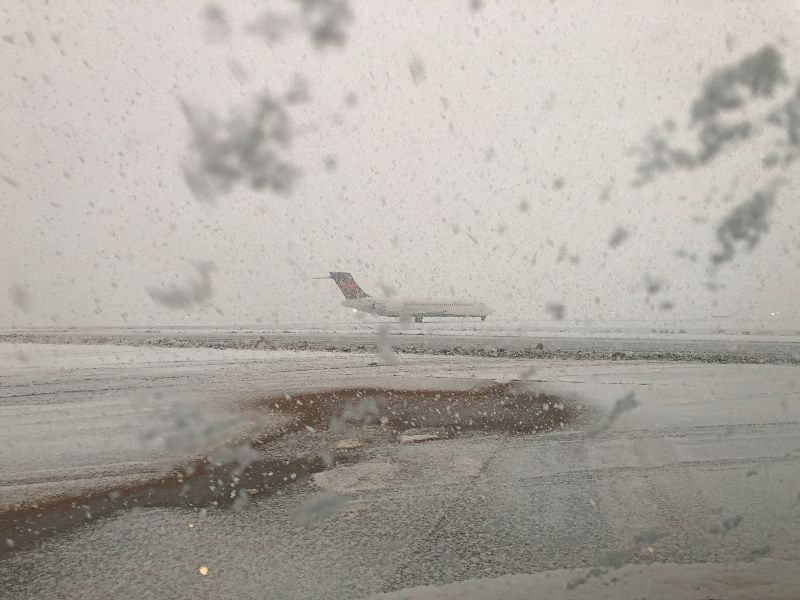
Q: How do you manage winter weather conditions?
Did you know that SEA was the first U.S. airport in 1990 to receive approval from the Federal Aviation Authority (FAA) to fly using instruments in low visibility conditions? So we have procedures to operate in heavy weather conditions and to keep the airport open. But, the airport does not make the final decision whether a flight takes off or lands.
Those decisions are made by the following parties:
Federal Aviation Authority
The Federal Aviation Authority’s Air Traffic Control directs plane traffic in and out of an airport, and sets guidelines for operation and best practices. Controls ground stop and ground delays.
Airlines
- Set flight schedules
- Decides whether a flight is cancelled or delayed
- Maintains the area around its gate
- De-icing for planes
- Manage the gate area, customer service, and airplane boarding
NOAA/NWS
The National Oceanic and Atmospheric Administration (NOAA) and National Weather Service (NWS) serve as an advisor to provide guidance on storm conditions and impacts.
Q: What do you mean when you say "Snow Watch"?
The following alert levels are used to classify winter weather events at SEA.
Snow Watch
Approximately 24 hours prior to the forecasted start of snow or icing conditions at SEA, or when the snow level in the greater Seattle area is between 600 and 1000 feet, a Snow Watch may be declared by the Airport Duty Manager.
Snow Warning
Approximately 24 hours prior to the forecasted start of snow or icing conditions at SEA, or when the snow level in the greater Seattle area is below 600 feet, a Snow Warning may be declared by the Airport Duty Manager.
Snow Advisory
Approximately 8 hours prior to the forecasted start of a snow or ice event of 2” of snow or less in a 24-hour period, freezing rain/drizzle (less than ¼”), or as otherwise determined by the Senior Manager, Airport Operations. Snow Advisory will be declared by Airport Operations Manager or designee.
Snow Alert
At any time if forecasted accumulation of snow is greater than 3” in a 24 hr period, freezing rain warning (1/4” or more), or as otherwise determined by the Senior Manager, Airport Operations
Snow Demobilization
At any time after a snow event where snow removal has taken place, Snow Demobilization will be declared by the Airport Operations Manager or designee. SCC will reduce to a modified staffing level and ramp cleanup will continue until areas return to normal operations.
Q: What do I do if there is snow at the airport?
1. Come to the airport and help us shovel (just kidding — we have it under control with all available resources working hard including local contractors who are standing by when we need help).
Did you know that in the February 2019 storm, the SEA team cleared three million cubic yards of snow from airport ramps and runways? That’s enough snow to fill 48 Olympic-sized swimming pools!

2. Stay safe
Our first priority is to keep you safe at the airport, but the rest of the journey is up to you. The most important thing is for you to get yourself to the airport safely.
- Take Link light rail or other public transportation if you can
- Stay in a hotel near the airport the night before if that’s an option
- Change your flight if you have that flexibility. The airlines generally waive charges on cancellations in big weather events
3. Plan for extra time to get to the airport and get through. We know it’s particularly tough on those early morning flights, but we will be here with you with a cup of coffee, a smile, directions to the fastest line, and some help getting you out of here as quickly as humanly possible.
4. Don’t expect business as usual
When Mother Nature throws a fit, it’s never going to be the same-old-same-old. Your journey may not be run of the mill — but it also may not be as bad as you expect. Don’t expect major closures (which rarely ever happen), but do think ahead about how you will handle a slower than normal day. Join us in preparing for the worst, but hoping for the best — and working hard to make it happen.
5. Stay informed
- Ask questions and be proactive about navigating your journey. When you get here, check with the Pathfinders in teal jackets or volunteers in blue jackets to find out which is the shortest line.
- Download the SEA Airport App to check security wait times and flight departures and arrivals. And plan your trip around this information.
6. Dress for inclement weather
We get that you’re on your way to Hawaii and just can’t wait to show off your pedicure. We are jealous and we will think of you as we shovel! But be sure to arrive at the airport dressed for the Seattle weather. In some cases as with ground boarding, you may need to walk in the snow or ice. We don’t want you to freeze your feet or slip on winter weather.










